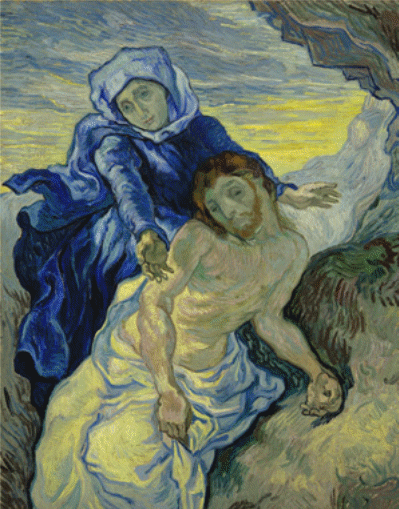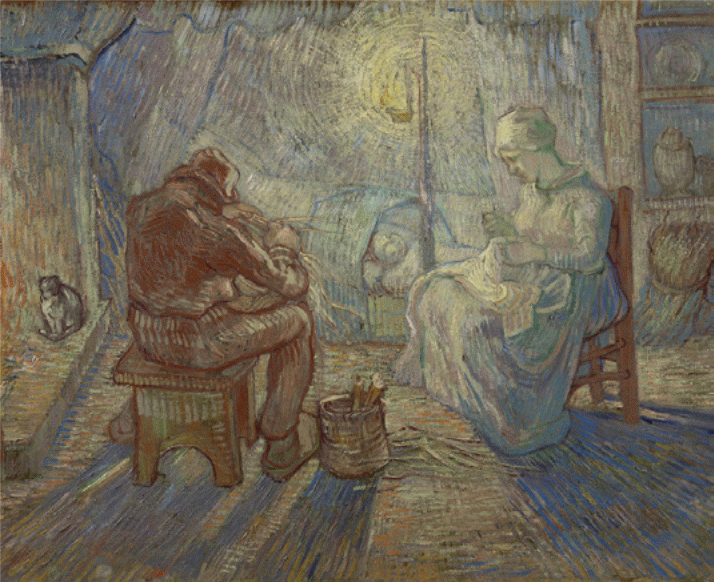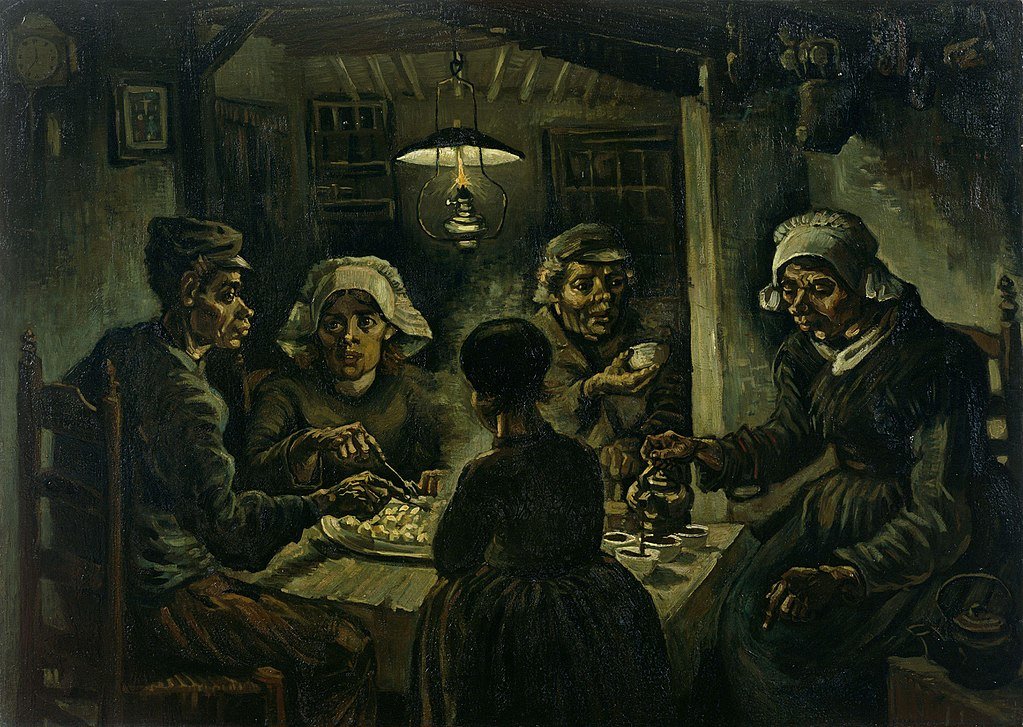Introduction
Born in 1853, Vincent Wilem Van Gogh was one of the renowned artists of the 19th century. According to Callow (1990), Van Gogh was a painter “whose work was notable for its beauty, emotional honesty, and bold color with a far reaching influence on 20th century art” (13).
The painter began drawing at an early age. He continued to do as he grew up until the time when he decided to pursue the painting art during his late twenties. He produced some of his most renowned paintings in his last two years before he died at the age of 37.
The pace at which he produced his paintings attracts the attention of Bernard (2004) who notes, “he produced more than 2100 artworks consisting of 860 oil paintings and more than 1300 watercolors, drawings, sketches, and prints” (p.45).
Other major works of the artist consist of self-portraits, still-life paintings of various images such as sunflowers, wheat fields, and cypresses.
Being a member of the clergy constituted one of the major aspirations of Van Gogh’s, which made him toil as a messenger in the quarry section of Belgium in 1879. However, while working this way, he still pursued the dream of paintings in that he sketched people.
Later, he was to release his major paintings that he referred to as potatoes eaters in 1885, which was later followed by the release of other paintings.
The inspirations behind the paintings of Van Gogh have attracted scholarly interest with some scholars arguing out that his mental challenges formed a major source of his painting aspirations.
This paper argues that van Gogh’s paintings were inspired by unanswered love that fueled his artistic creativity rather than mental illness. The paper also paper introspect the part that romance played in his life and his artistic works with a focus on how he depicted women in is paintings.
Romance: Unanswered Love that fueled Van Gogh’s Artistic Creativity
Van Gogh was one of the artists of the 19th century who has captured the attention of many people.
Some of the creative people preceding him such as Andy Warhol made inventive works that proved hard to disconnect truth from the legends that characterized the persona and the life of the painting creator.
This argument was perhaps not the case of the van Gogh’s paintings. He was able to articulate his personality and character well in his paintings.
Callow (1990) supports this argument by adding, “Van Gogh’s unbridled passion and ecstatic contemplation of life, nature, and art, his intense spirituality and religious zeal, his generous, ardent, and sincere disposition are well showcased in his painting and letters” (32).
Although judging the character of an artist is a hard endeavor, which helps to give an indication of the main aspirations of the artist’s works, for the case of Van Gogh, it is relatively easier since most of his letters, for instance the letters exchanged between him and his brother Theo, were written in the first person.
Nevertheless, as Bernard (2004) maintains, “Van Gogh’s letters offer us a poignant and lucid view into the remarkable artist’s personal struggles and complex psychology, but little objective information from other parties has been found” (p.46).
The letters are responses to the experiences in a world in which Van Gogh lived. This world embraces people living with their loved ones as reflected in the 1889 painting by Van Gogh.
However, it is arguable that Van Gogh felt isolated from this world by virtue of his commitments to “unwavering, almost evangelical, artistic mission, and his affliction” (Bernard 2004, 55).
From the painting shown in fig 1 below, it is evident that Van Gogh had a particular perception of how romance can be portrayed from an emotional perceptive as opposed to through actual pictures.

Source (McQuillan 2000)
In a letter to Theo in 1885, Van Gogh supports the above argument when he wrote stating, “Romance and romanticism are our era, and one must have imagination sentiment in painting” (McQuillan 2000, 3).
Referring to fig 1, the romance between a woman and a man is evident in the painting in the context of the mood created by the painting.
The choice of hue and implied texture of the painting suggests a situation in the life of the persons shown in the painting thus prompting one party to support the other party emotionally. These aspects are associated with romantic artistic works.
Arguably, the painting of each of the characters in the work with respect to the subject matter is astounding.
Perhaps the man is in agony, and desires the help of the woman located strategically just behind him extending hands to imply the degree to which she sympathizes with the situation of the man.
From the approach of romanticism, the depiction of a character extending hands open to embrace the other shows the extent of preparedness to accord help. As an artistic work, painting is a reflection of what runs in the mind of people through the power of imagination of an author.
This assertion overrules the influence of mental illness that affected Van Gogh, which some scholars argue as influencing his paintings that portray romance such as the one shown in fig 1.
The validity of this argument has the implication of suggesting that Van Gogh’s tireless efforts, amid his mental challenges, which some people believe to have culminated to his suicide, rested on the wave of romanticism that influenced many literary works of scholars living in his time.
Callow (1990) subscribes to this school of thought by further suggesting, “Van Gogh’s dedication to articulating the inner spirituality of man and nature resulted in dramatic, imaginative, rhythmic, and emotional canvases that convey far more than the mere appearance of the subject” (p.91).
Directly congruent with this position, it is also arguable that Van Gogh’s wits in the selection and deployment of spontaneous gestural relevance of representative tints together with smears were artistic tactics of portraying prejudiced feelings.
One can put such emotions on a piece of canvas if they are consistent and run articulately in the mind of a painting creator.
The underlining argument here is that themes that are showcased in a painting or any other artistic work are a description of personality, norms, and ideologies to which the creator of the painting subscribes.
A painting creator wants such celebrity and principles to remain strongly anchored in the history of humankind. Arguably, Van Gogh is one of such talented artists whose romantic nature of some of his painting cannot be contested.
Upon revisiting the subject matter of the painting in fig1, it is clear that Van Gogh valued the role of romanticism to alleviate loneliness. However, as suggested by the painting, according to Van Gogh, women are presented as tools for alleviation of men’s loneliness.
This argument perhaps shows the sexual orientation of Van Gogh although it is a point of contest in the modern world where issues of equality of all human beings irrespective of their sexual inclinations are standing out as significant matters that shape the cultures of people.
The interrelation of romance and loneliness in addition to how the two influenced some of the paintings of Van Gogh such as the one shown in fig 1 is evident in Callow’s (1990) words. He argues, “Van Gogh’s fear of being alone was central to his disturbed outlook on life” (Callow 1990, 67). The need for companionship is well developed by the disturbed man of the painting shown in fig1.
The obvious solution to these problems is the woman shown behind the man. Indeed, the feeling of loneliness became incredibly amplified in the last part of Van Gogh’s life when he became hospitalized while his mental state was at the lowest point.
This experience perhaps speaks volumes of the theme of romance running in some of his paintings. Consequently, it sounds sufficiently imperative to infer that an artistic work is a reflection of one’s direct or indirect experiences in life.
Therefore, it highlights the painter’s position on what should be done to rectify certain disturbing challenges of humanity. Need for love and embracement is one of these solutions as suggested by some of paintings by Van Gogh such as the one shown in fig 2 below.
The figure shows a man and woman providing companionship to one another in what is seemingly a peaceful family having a nice evening. The painting was done in 1889.

Fig 2: Source (McQuillan 2000)
Part played by Romance in Van Gogh’s Life and in His Artistic Works
As argued in the previous section, feeling of loneliness is a major contributor of the artistic work of Van Gogh in the manner in which he portrayed romance in his paintings and writings.
Arguments on how the issues culminating into romanticizing of Van Gogh’s paintings were reflected in his artistic works have been developed in the previous sections.
Consequently, no further treatments of the same are considered in this section. Rather, dedication is made to discuss how romance influenced Van Gogh’s life.
The perceptions of lack of romance in his life rendered Van Gogh lonely. Bernard (2004) supports this assertion by further noting, “Van Gogh’s fear for being alone was central to his disturbed outlook on life” (p.49).
The manifestation of these fears is evidenced by the constant pull for suicide that he possessed although many critics associated it with his deteriorating mental conditions. Van Gogh even sought refuge for his situations by indulging in alcoholism.
The central argument here is that alcoholism was a major contributing factor for his demise. This problem was related to his lack of a romantic life. Van Gogh admitted, “he did not have any children…he viewed his painting as his progeny” (Bernard 2004, 17).
It is then not by surprise that Van Gogh could have sought companionship elsewhere in paintings in which he attempted to express his emotions speaking volume of the manner he perceived life.
Indeed, he even wrote to his sister explaining that his main desire was to paint a picture that would live through different generations, and which would act as a major aspiration.
To realize this dream, he continued to inform her sister, “…I mean that I do not endeavor to achieve this goal through photographic resemblance, but by means of our impassioned emotion” (McQuillan 2000, 5).
From this self-confession, it is arguable that Van Gogh paintings were a reflection of the emotions running deep inside him.
The evening painting of 1889 is then a depiction of how he felt concerning how couples in deep affection live to provide companionship to one another. Unfortunately, Van Gogh had not experienced this situation in his life.
Loneliness overwhelmed him to the extent that he observed, “to such a horrible extent that I shy away from going out” (McQuillan 2000, 7). Tantamount to the ways of life of people who are deeply indulged in alcoholism, Van Gogh did not live alone.
Alcohol formed a major share of his erratic behavior. It acted as one single medicine that accorded him a feeling of self-belief although it later destroyed him.
As a repercussion of its abuse, alcohol not only made him isolated from the rest of the people he lived with but also made him romantically lonely. The argument holds because “no one wanted to be near him because of his distressing effects” (Bernard 2004, 87).
Consequently, in the effort to run away from the true nature of companionship as an essential facet of people’s life, Van Gogh’s loneliness intensified with consequential increased impacts on the deterioration of his mental state.
The concerns and desire for him to mingle with other people are perhaps well evidenced by his 1888 painting The Night Café and the Dancehall. In particular, in this painting, the artist created an outstanding relief by describing what he perhaps thought a dancehall needed to have.
The attention of the painting admirer is caught up by the enhanced color and size of images of women. Does this mean that Van Gogh had a deep-seated belief that women should grace dancehalls? Response to this query is subject to discussions of portrayal of women in his paintings.
Presentation of Women in Van Gogh Paintings
In some of his paintings, women are portrayed as figures that provide glamour in homes and companionship to men. This hypothetical assertion can be developed by considerations of the analysis of some of Van Gogh’s paintings.
In this section, only three of these paintings are considered. These are The Potatoes Eater as shown in fig 3 and the paintings used previously in the discussions of this paper as shown in fig 1 and fig 2.

Fig 3: Source (Van Gogh Gallery 2003)
The Potato Eaters was finished in 1885. It is taken by many commentaries of the Van Gogh’s painting as one of his greatest artistic achievement. With regard to Bernard (2004), “Van Gogh wished to create his first masterpiece that could boost his reputation as a developed artist” (27).
The noble goal that Van Gogh wanted to attain was to paint human figures that were not awkward. He needed to come up with ones, which existed in the natural form. Therefore, it implies that he painted a picture that conformed to his interpretation of his environment in which he lived.
Upon a quick look at the fig 3, the painting comprises five figures sitting around a table. Four of these figures are women. Although the painting depicts people in a dark lighted room, the emotions of the persons residing in the room are mixed.
They come out shining brightly. Indeed, the intensity of the figures is so enormous that an admirer of the painting can hear a conversation that ensues among the five figures.
Considering the strategic positioning of the male and the attention that female figures have towards the male counterparts, it is evident that the male figure is in charge of the conversations taking place.
This strategy perhaps explains males’ domineering power in the period in which Van Gogh lived.
The unevenness of the number of figures portrayed in fig 3 in terms of gender shows that male figures could take charge of more than one woman. The painting shows a number of features.
They include rafter boards, picture frame hanging from the darkened wall, a female figure pouring out brew similar to that of coffee, and a table that has some weathered edges among others.
These aspects make an admirer of the painting develop a perception that the figure resides in the home depicted in the painting.
The female figures depict mature women. Could this possibly mean that they could all be the wives to these male figures? Should this be the case, it means that Van Gogh was influenced by the societal norms of the late 1880s, which welcomed the practice of polygamy.
In the history of evolution of women roles in the societies, it is until 1930s that women roles in the paid jobs began to be recognized.
Women were mainly accustomed to domestic chores including sewing during their free times after accomplishing other tasks such as cooking and taking care of children. Coincidentally, this case happens to be the theme developed by the evening painting shown in fig 2.
In the period of history of women in the times of Van Gogh, women were principally the caretakers of their men. They attended to their physical and emotional needs. It is not surprising that fig.1 shows a distressed man with a woman behind him.
The woman is seemingly attending to the emotional needs of the man who seems missing something crucial in life.
In overall, the three paintings shown in fig 1, 2, and 3 respectively imply that women had some certain gender-determined roles and manners of living. Thus, Van Gogh was not shy to portray them this way.
Conclusion
Van Gogh is one of the renowned artists who lived for a very short time (1853 to 1890). Nevertheless, his paintings have survived his artistic talents especially by noting that he did not have any children to survive him.
It was held in the paper that many scholars contend that most of his paintings were inspired by his mental illness, which influenced the artistic impression of the paintings.
However, the paper took a different dimension to the analysis of Van Gogh’s paintings in that it argued that the paintings were inspired by his unanswered love that fueled his artistic creativity rather than his mental illness.
This position was supported by his writings admitting that his paintings were inspired by the needs to portray emotions through paintings that would live through centuries. The paper also held that the paintings’ depicted themes such as gender roles as determined by the society in which he lived.
Bibliography
Bernard, Bruce. Vincent by Himself. London: Time Warner, 2004.
Callow, Philip. Vincent van Gogh: A Life. Chicago: Ivan R. Dee, 1990.
McQuillan, Melissa. Vincent Van Gogh and Nineteenth-Century Art. London: Routledge, 2000.
Van Gogh Gallery. “Brief Understanding of the Potato Eaters Painting.” Web.